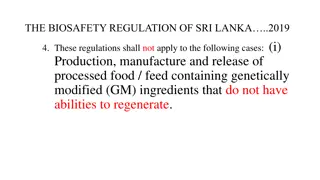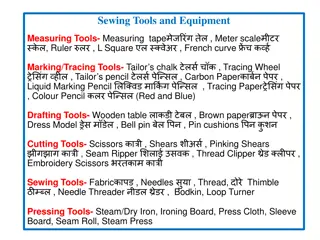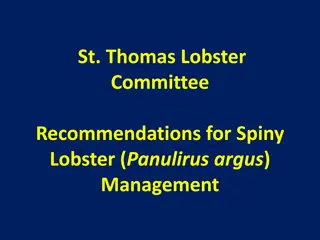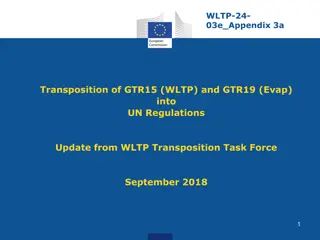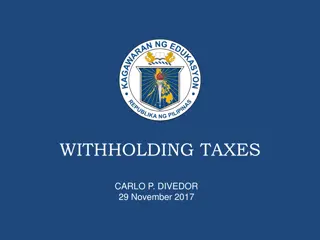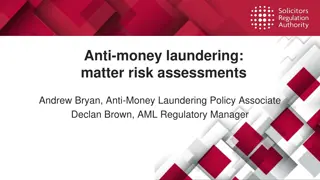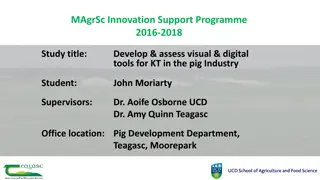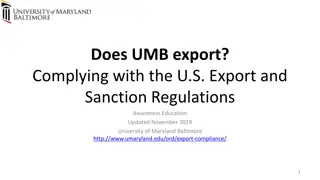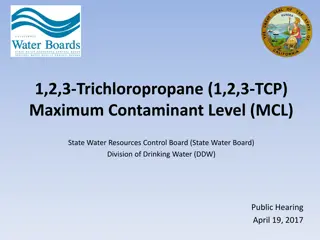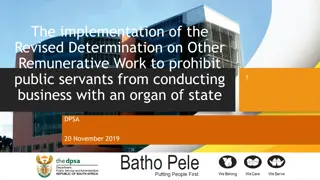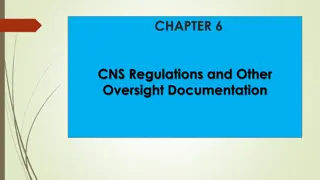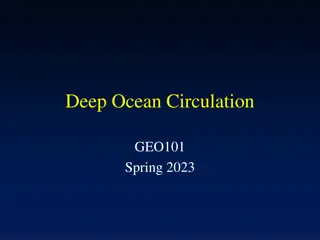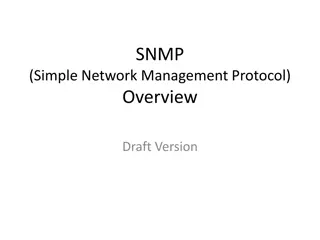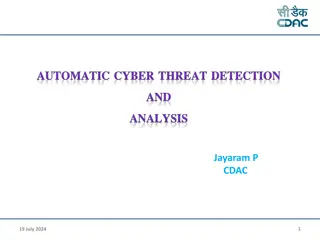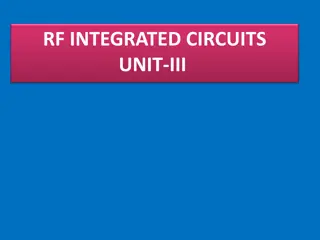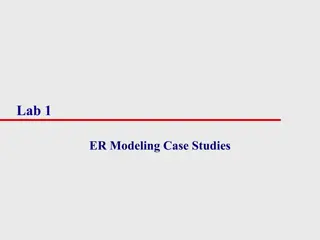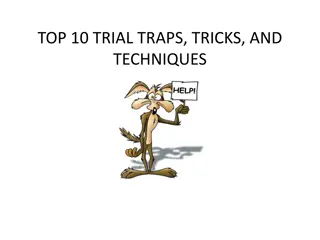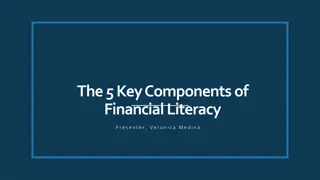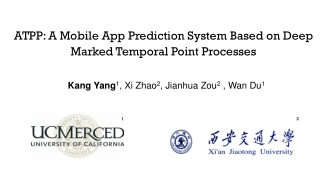Deep Dive into TRID Regulations: Tips, Traps, and Tools
Delve into the complexities of TRID regulations with expert insights on expanded coverage, pre-qualification best practices, business days, loan types, and more. Understand key aspects such as CFPB requirements for title policies and fee categorization, tolerance calculations, APR disclosures, and liability disclosures after foreclosure. Gain valuable tips on TRID compliance and access essential tools for seamless implementation.
Download Presentation

Please find below an Image/Link to download the presentation.
The content on the website is provided AS IS for your information and personal use only. It may not be sold, licensed, or shared on other websites without obtaining consent from the author. Download presentation by click this link. If you encounter any issues during the download, it is possible that the publisher has removed the file from their server.
E N D
Presentation Transcript
12 TRID Tips, Traps and Tools aka "The TRID Dirty Dozen aka Deep Into the TRID Weeds
12 TRID Tips, Traps and Tools aka"The TRID Dirty Dozen aka Deep Into the TRID Weeds #1 Expanded Coverage #2 Pre-Qualification Dos and Don ts #3 Business Days #4 Loan Type #5 Loan Purpose #6 CFPB new required calculation of simultaneous issue of owner and lender title policies #7 Which bucket do which fees go in? #8 Tolerance and Baseline Calculations #9 APR Over Disclosure vs. Under Disclosure (the law vs the investor) #10 Right of Rescission and Material Disclosures #11 CFPB s Required Disclosure of Liability after foreclosure in Texas #12 Consent for Real Estate Agent to Receive TRID Disclosures -Bonus: TRID-Obsolete Docs, Amended Docs and New Docs -Other P&P TRID Tools For PowerPoint see: http://www.ppdocs.com/TRID/ Fort Worth Mortgage Bankers Presentation By Mike Patterson 9-9-2015
#1 Expanded Coverage TRID is within Reg Z, but don t forget basic Reg Z coverage and exemptions (emphasis): (c) Coverage. (1) In general, this part applies to each individual or business that offers or extends credit, other than a person excluded from coverage of this part by section 1029 of the Consumer Financial Protection Act of 2010, Title X of the Dodd-Frank Wall Street Reform and Consumer Protection Act, Public Law 111 203, 124 Stat. 1376, when four conditions are met: (i) The credit is offered or extended to consumers; (ii) The offering or extension of credit is done regularly; (iii) The credit is subject to a finance charge or is payable by a written agreement in more than four installments; and (iv) The credit is primarily for personal, family, or household purposes By Michael Patterson
#1 Expanded Coverage Non-owner-occupied rental property exception (emphasis): 4. Non-owner-occupied rental property. Credit extended to acquire, improve, or maintain rental property (regardless of the number of housing units) that is not owner-occupied is deemed to be for business purposes. This includes, for example, the acquisition of a warehouse that will be leased or a single-family house that will be rented to another person to live in. If the owner expects to occupy the property for more than 14 days during the coming year, the property cannot be considered non- owner-occupied and this special rule will not apply. For example, a beach house that the owner will occupy for a month in the coming summer and rent out the rest of the year is owner occupied and is not governed by this special rule. ( See comment 3(a) 5, however, for rules relating to owner- occupied rental property.) By Michael Patterson
#1 Expanded Coverage Owner-occupied rental property exception (emphasis): 5. Owner-occupied rental property. If credit is extended to acquire, improve, or maintain rental property that is or will be owner-occupied within the coming year, different rules apply: i. Credit extended to acquire the rental property is deemed to be for business purposes if it contains more than 2 housing units. ii. Credit extended to improve or maintain the rental property is deemed to be for business purposes if it contains more than 4 housing units. Since the amended statute defines dwelling to include 1 to 4 housing units, this rule preserves the right of rescission for credit extended for purposes other than acquisition. Neither of these rules means that an extension of credit for property containing fewer than the requisite number of units is necessarily consumer credit. In such cases, the determination of whether it is business or consumer credit should be made by considering the factors listed in comment 3(a) 3.
#1 Expanded Coverage Remember RESPA is property type driven. TILA/Reg Z is loan purpose driven. TRID is a part of TILA/Reg Z not RESPA!!!! Scenario: Borrower (individual) pledges a duplex, land or lot as collateral. Covered by TRID maybe!!!! What is the loan purpose? Investment or send his kids to college? This is not a new problem .but the penalty for guessing wrong is now much higher!!! P&P advice if not doing TRID disclosures: Loan purpose affidavit for all non-TRID transactions containing at least the following: Lender is making a loan to Borrower which will be secured by the above referenced Property. Borrower acknowledges that Lender will have a security interest in said Property. Borrower represents that the purpose of this loan is either for business, commercial or agricultural purposes and as such is exempt from the provisions of the Real Estate Settlement and Procedures Act, Truth in Lending Act and their Regulations X and Z. Borrower understands that Lender relies upon and accepts as true, the representations made in this Affidavit.
#1 Expanded Coverage TRID Coverage: CFPB The TILA-RESPA rule applies to most closed-end consumer credit transactions secured by real property. Credit extended to certain trusts for tax or estate planning purposes is not exempt from the TILA-RESPA rule. However, some specific categories of loans are excluded from the rule. Specifically, the TILA-RESPA rule does not apply to HELOCs, reverse mortgages or mortgages secured by a mobile home or by a dwelling that is not attached to real property (i.e., land). By Michael Patterson
#1 Expanded Coverage Exemptions -Open end aka HELOCS -Non consumer e.g. loans to corporations and other entities NOT DBAs though -Business, commercial or agricultural loans -Reverse mortgages -Unsecured loans -Secured by personal property that is not a dwelling -Secured by personal property that is a dwelling and is not also secured by real property -Creditor that makes five or fewer mortgage loans in one year -Certain narrowly defined 2nd liens e.g. housing assistance 2nds By Michael Patterson
#1 Expanded Coverage Exemptions 1026.3 -- Exempt transactions. (a) Business, commercial, agricultural, or organizational credit. (1) An extension of credit primarily for a business, commercial or agricultural purpose. (2) An extension of credit to other than a natural person, including credit to government agencies or instrumentalities. By Michael Patterson
#1 Expanded Coverage Exemptions ii. Business-purpose examples. Examples of business- purpose credit include: A. A loan to expand a business, even if it is secured by the borrower's residence or personal property. B. A loan to improve a principal residence by putting in a business office. C. A business account used occasionally for consumer purposes By Michael Patterson
#1 Expanded Coverage Exemptions iii. Consumer-purpose examples. Examples of consumer- purpose credit include: A. Credit extensions by a company to its employees or agents if the loans are used for personal purposes. B. A loan secured by a mechanic's tools to pay a child's tuition. C. A personal account used occasionally for business purposes. By Michael Patterson
#1 Expanded Coverage Exemptions 8. Agricultural purpose. An agricultural purpose includes the planting, propagating, nurturing, harvesting, catching, storing, exhibiting, marketing, transporting, processing, or manufacturing of food, beverages (including alcoholic beverages), flowers, trees, livestock, poultry, bees, wildlife, fish, or shellfish by a natural person engaged in farming, fishing, or growing crops, flowers, trees, livestock, poultry, bees, or wildlife. The exemption also applies to a transaction involving real property that includes a dwelling (for example, the purchase of a farm with a homestead) if the transaction is primarily for agricultural purposes.
#1 Expanded Coverage NOT Exemptions---NEW COVERAGE!!! -Lot loans -Land more than 25 acres -Construction loans to individuals and trusts 3 Requirements: 1) consumer purpose , 2)closed end, and 3)dirt as part of the collateral Weird examples: survey? Require survey deletion in title policy? 2)Pledge manufacturing company and property to secure personal debt consolidation. TRID? 3) A loan to expand a business secured by the borrower's residence. TRID? 1)200 acres hunting property in Palo Pinto County. TRID? Require a
#1 Expanded Coverage POSSIBLE Exemptions -Assumptions This if from the CFPB s Aug 24, 2015 Webcast: By Michael Patterson
#1 Expanded Coverage POSSIBLE Exemptions -Assumptions CFPB: .The short answer is yes, assuming that when we re saying assumptions, we mean a post-consummation event that is deemed a new closed-end credit transaction according to an existing provision of Regulation Z Reg Z and RESPA: Any assumption in which the lender's permission is both required and obtained is covered by RESPA and this part, whether or not the lender charges a fee for the assumption. By Michael Patterson
#1 Expanded Coverage POSSIBLE Exemptions -Modifications If NOT a Reg Z Refinancing Reg. Z, Section 1026.20: 1026.20 Disclosure requirements regarding post-consummation events. (a) Refinancings. A refinancing occurs when an existing obligation that was subject to this subpart is satisfied and replaced by a new obligation undertaken by the same consumer. A refinancing is a new transaction requiring new disclosures to the consumer. The new finance charge shall include any unearned portion of the old finance charge that is not credited to the existing obligation. The following shall not be treated as a refinancing: (1) A renewal of a single payment obligation with no change in the original terms. (2) A reduction in the annual percentage rate with a corresponding change in the payment schedule. (3) An agreement involving a court proceeding. (4) A change in the payment schedule or a change in collateral requirements as a result of the consumer's default or delinquency, unless the rate is increased, or the new amount financed exceeds the unpaid balance plus earned finance charge and premiums for continuation of insurance of the types described in 1026.4(d). (5) The renewal of optional insurance purchased by the consumer and added to an existing transaction, if disclosures relating to the initial purchase were provided as required by this subpart.
#1 Expanded Coverage POSSIBLE Exemptions -Modifications Official Staff Commentary to Section 1026.20(a): 20(a) Refinancings 1. Definition. A refinancing is a new transaction requiring a complete new set of disclosures. Whether a refinancing has occurred is determined by reference to whether the original obligation has been satisfied or extinguished and replaced by a new obligation, based on the parties' contract and applicable law. The refinancing may involve the consolidation of several existing obligations, disbursement of new money to the consumer or on the consumer's behalf, or the rescheduling of payments under an existing obligation. In any form, the new obligation must completely replace the prior one. i. Changes in the terms of an existing obligation, such as the deferral of individual installments, will not constitute a refinancing unless accomplished by the cancellation of that obligation and the substitution of a new obligation. ii. A substitution of agreements that meets the refinancing definition will require new disclosures, even if the substitution does not substantially alter the prior credit terms.
#2 Pre-Qualification Dos and Donts The Rule and Official Staff Commentary Effective October 3, the definition of application for TRID purposes will be as follows: Reg. Z, Section 1026.2(a)(3): (3) (i) Application means the submission of a consumer's financial information for the purposes of obtaining an extension of credit. (ii) For transactions subject to 1026.19(e), (f), or (g) of this part, an application consists of the submission of the consumer's name, the consumer's income, the consumer's social security number to obtain a credit report, the property address, an estimate of the value of the property, and the mortgage loan amount sought.
#2 Pre-Qualification Dos and Donts A Don t : (iii) Verification of information. The creditor or other person shall not require a consumer to submit documents verifying information related to the consumer's application before providing the disclosures required by paragraph (e)(1)(i) of this section.
#2 Pre-Qualification Dos and Donts It appears the CFPB intends for the prohibition against requiring verifying information to also include the time period before an application has been completed. The rule, preamble, and CFPB s recent webcast comments clarify, however, that a creditor may collect any such verifying information at any time, as long as it is provided voluntarily by the consumer.
#2 Pre-Qualification Dos and Donts Another Don t : - Don t collect any fees other than for the credit report prior to Intent to Proceed -That prohibition includes holding checks or collecting a credit card # to be used for anything other than the credit report.
#2 Pre-Qualification Dos and Donts Another Don t : Application means submission of: (1) the consumer s name; (2) the consumer s income; (3) the consumer s social security number to obtain a credit report; (4) the property address; (5) an estimate of the value of the property; and (6) the loan amount sought. ( 1026.2(a)(3)). No longer includes catch-all of any other information deemed necessary by the loan originator.
#2 Pre-Qualification Dos and Donts Any Do s ?
#2 Pre-Qualification Dos and Donts Any Do s ? -Can prequalify prior to getting all 6 pieces of information. However, if a consumer is provided with a written estimate of terms or costs before receiving the LE: 1)Top of the first page must contain a statement that Your actual rate, payment, and costs could be higher. Get an official Loan Estimate before choosing a loan. ; 2)The estimate may not be made with headings, content, and format substantially similar to the LE form and must be in no smaller than 12-point font.
#3 Business Days For purposes of providing the Loan Estimate, a business day is a day on which the creditor s offices are open to the public for carrying out substantially all of its business functions. However, the term business day is defined differently for other purposes; including counting days to ensure the consumer receives the Closing Disclosure on time. For these other purposes, business day means all calendar days except Sundays and the legal public holidays specified in 5 U.S.C. 6103(a), such as New Year s Day, the Birthday of Martin Luther King, Jr., Washington s Birthday, Memorial Day, Independence Day, Labor Day, Columbus Day, Veterans Day, Thanksgiving Day, and Christmas Day. See-P&P Online Interactive Calendar:http://www.ppdocs.com/TRID/ Key in the applicable dates and the calendar will calculate the first eligible date for closing.]
#4 Loan Type (11) Loan type. The type of loan, labeled Loan Type, offered to the consumer using one of the following terms, as applicable: (i) Conventional. If the loan is not guaranteed or insured by a Federal or State government agency, the creditor shall disclose that the loan is a Conventional. (ii) FHA. If the loan is insured by the Federal Housing Administration, the creditor shall disclose that the loan is an FHA. (iii) VA. If the loan is guaranteed by the U.S. Department of Veterans Affairs, the creditor shall disclose that the loan is a VA. (iv) Other. For federally-insured or guaranteed loans other than those described in paragraphs (a)(11)(ii) and (iii) of this section, and for loans insured or guaranteed by a State agency, the creditor shall disclose the loan type as Other, and provide a brief description of the loan type. By Michael Patterson
#4 Loan Type Home equity loan=Conventional Lot loan=Conventional Initial construction loan=Conventional Home improvement loan=Conventional By Michael Patterson
#5 Loan Purpose (9) Purpose. The consumer's intended use for the credit, labeled Purpose, using one of the following terms: (i) Purchase. If the credit is to finance the acquisition of the property identified in paragraph (a)(6) of this section, the creditor shall disclose that the loan is for a Purchase. (ii) Refinance. If the credit is not for the purpose described in paragraph (a)(9)(i) of this section, and if the credit will be used to refinance an existing obligation, as defined in 1026.20(a) (but without regard to whether the creditor is the original creditor or a holder or servicer of the original obligation), that is secured by the property identified in paragraph (a)(6) of this section, the creditor shall disclose that the loan is for a Refinance. (iii) Construction. If the credit is not for one of the purposes described in paragraphs (a)(9)(i) or (ii) of this section and the credit will be used to finance the initial construction of a dwelling on the property identified in paragraph (a)(6) of this section, the creditor shall disclose that the loan is for Construction. (iv) Home equity loan. If the credit is not for one of the purposes described in paragraphs (a)(9)(i) through (iii) of this section, the creditor shall disclose that the loan is a Home Equity Loan.
#5 Loan Purpose What will be the Loan Purpose for Construction Loans? - Purchase if any of the funds go toward the lot purchase. -If no funds go toward the lot purchase, then Refinance if any of the funds go toward refinance. -If no funds go toward the lot purchase and no funds go toward refinance and the funds going toward construction is for the initial construction of a dwelling on the property the purpose is Construction -If no funds go toward the lot purchase and no funds go toward refinance and the funds going toward construction is NOT for the initial construction of a dwelling on the property the purpose is Home Equity
#5 Loan Purpose What will be the Loan Purpose for Lot Loans? - Purchase if any of the funds go toward the lot purchase. -If no funds go toward the lot purchase, then Refinance if any of the funds go toward refinance. -If no funds go toward the lot purchase and no funds go toward refinance the purpose is Home Equity
#6 CFPB New Required Calculation of Simultaneous Issue of Owner and Lender Title Policies TRID Requirement: Owner s title insurance premium. In a jurisdiction where simultaneous issuance title insurance rates are permitted, any owner s title insurance premium disclosed under 1026.38(g)(4) is calculated by using the full owner s title insurance premium, adding any simultaneous issuance premium for issuance of lender s coverage, and then deducting the full premium for lender s coverage disclosed under 1026.38(f)(2) or (f)(3). By Michael Patterson
#6 CFPB New Required Calculation of Simultaneous Issue of Owner and Lender Title Policies TILA-RESPA Integrated Disclosures, Part 5: Implementation Challenges and Questions Tuesday, May 26, 2015-Slides 20 and 21 From transcript: Minutes 34.18-36.12 (With emphasis) Turning back to the question posed, concerning how the creditor shows the allocation of costs when the seller has agreed to pay for the owner's title insurance cost as part of the purchase and sales contract with the consumer. Because the final rule provides that the incremental cost of the owner's title insurance is to be disclosed on the loan estimate and the closing disclosure, simply shifting the incremental cost of the owner's title insurance to the seller on the closing disclosure may not completely reflect the amounts that the seller has agreed to pay for the owner's title policy. If there is an additional amount from the seller's credit, there are at least three ways in which the additional credit between the seller and consumer may be disclosed on the closing disclosure. First, the remaining credit could be applied toward any other title insurance costs including the lender s title insurance cost. See 1026.38(f)&(g), Second, the remaining credit can be considered to be a general seller credit and disclosed as such in the summaries of transactions table on page 3 of the closing disclosure. See 1026.38(k)(2)(vii). Third, some in the industry have suggested providing a credit specifying the remaining amount for the owner's title insurance cost-again in the summaries of transactions on page 3 of the closing disclosure. See 1026.38(k)(2)(viii). Any one of these three methods to disclose the remaining amount of seller credit for an owner title policy is permissible under the final role.
#6 CFPB New Required Calculation of Simultaneous Issue of Owner and Lender Title Policies
#6 CFPB New Required Calculation of Simultaneous Issue of Owner and Lender Title Policies See P&P Online Owner Title Policy Simultaneous Calculator: http://www.ppdocs.com/TRID/ In many states, a consumer is entitled to a discount on loan title insurance policy when an owner s policy will be simultaneously issued. When both a loan and owner s title insurance policies will be purchased ( simultaneous issuance ), the Rule requires the lender or settlement agent to disclose the title premiums on the Closing Disclosure in a way different than actually charged.
#7 Which Bucket do Which Fees Go In? FAQ: We have a prepaid finance charge list which shows which fees affect the APR. We have a Texas home equity fee sheet to determine which fees are counted toward the 3% cap So why don t we have a list, chart matrix or other tool to tell a lender which bucket (0% tolerance, 10% tolerance or NO tolerance) a particular fee should go in?????? Our answer: For purposes of fee tolerances for the most part, fees are not characterized by their name, but rather by another set of criteria. By Michael Patterson
#7 Which Bucket do Which Fees Go In? 0% Bucket: -Fees paid to the creditor. -Fees paid to a mortgage broker. -Fees paid to an affiliate of the creditor or a mortgage broker. -Fees paid to an unaffiliated third party if the creditor did not permit the consumer to shop for a third party service provider for a settlement service. -Named fee exception Transfer taxes . -Lender credits Specific and General No Cost Loan is now a best guess estimate at time of Loan Estimate!!! An underestimate results in a cure . An overestimate will cause a refund
#7 Which Bucket do Which Fees Go In? 10% Bucket: Fee is for a third-party (not paid to the creditor or an affiliate of the creditor) service or is a recording fee and the creditor permitted the consumer to shop for the third-party service and the consumer chose a third-party service ON the creditor s provider list. By Michael Patterson
#7 Which Bucket do Which Fees Go In? NO Tolerance Bucket: Fee is for a third-party (not paid to the creditor or an affiliate of the creditor) service, the creditor permitted the consumer to shop for the third-party service and the consumer chose a third-party service NOT ON the creditor s provider list. Named fee exceptions: -Prepaid interest -Property insurance -Escrow for impounds By Michael Patterson
#7 Which Bucket do Which Fees Go In? TRID Typical Fee Tolerances Bold Fees=Treatment should not vary. Unbold Fees=Teatment can vary based upon if "Paid to Creditor or Creditor Affiliate", "Required by Creditor", "Allowed to Shop" and "Chose from List" options. Typical 0% Examples Transfer taxes (per Reg) Origination fee Discount fee Appraisal Credit report Flood determination fee Flood monitoring fee Tax monitoring fee Tax status research fee Attorney fee-Doc Prep Application fee Underwriter fee Loan broker compensation Mortgage insurance FHA mortgage insurance VA guaranty fee Escrow waiver fee Buydown LLPs Lender Credits-General and Specific Any other Unbold Fees (if required by Creditor and NOT allowed to shop)
#7 Which Bucket do Which Fees Go In? Typical 10% Examples Recording fees (per Reg) Title-Owner's Title Insurance (optional)(if required by Creditor, allowed to shop & chose from the list) (common refinance scenario) Title-Lender's Title Insurance (if required by Creditor, allowed to shop & chose from the list)(common refinance scenario) Any other title insurance required fees (List each as "Title-(fee name)" if itemized)(if required by Creditor, allowed to shop & chose from the list) (common refinance scenario) Escrow fees (if required by Creditor, allowed to shop & chose from the list)(common refinance scenario) Courier or express mail (if required by Creditor, allowed to shop & chose from the list)(common refinance scenario) Survey (if required by Creditor, allowed to shop & chose from the list) Pest inspection (if required by Creditor, allowed to shop & chose from the list) Any other fee (if required by Creditor, allowed to shop & chose from the list) By Michael Patterson
#7 Which Bucket do Which Fees Go In? Typical "No Limit/None" Examples Prepaid interest (per Reg) Property insurance (per Reg) Escrows (per Reg) Property taxes Real estate commissions Property inspection HOA certificate HOA other type fees Title-Owner's Title Insurance (optional)(if required by Creditor, allowed to shop & NOT chose from the list; or NOT required by Creditor)(common purchase scenario) Title-Lender's Title Insurance (if required by Creditor, allowed to shop & NOT chose from the list; or NOT required by Creditor)(common purchase scenario) Any other title insurance required fees (List each as "Title-(fee name)" if itemized)(if required by Creditor, allowed to shop & NOT chose from the list; or NOT required by Creditor)(common purchase scenario) Escrow fees (if required by Creditor, allowed to shop & NOT chose from the list; or NOT required by Creditor)(common purchase scenario) Courier or express mail (if required by Creditor, allowed to shop & NOT chose from the list; or NOT required by Creditor)(common purchase scenario) Survey (if required by Creditor, allowed to shop & NOT chose from the list; or NOT required by Creditor) Pest inspection (if required by Creditor, allowed to shop & NOT chose from the list; or NOT required by Creditor) Any other fee (if required by Creditor, allowed to shop & NOT chose from the list; or NOT required by Creditor)
#7 Which Bucket do Which Fees Go In? Decision Tree Matrix Paid to Broker or Affiliate of Creditor or Broker Can Shop Borrow er Chose From List Paid to Creditor Specified Treatment Per Reg Required Svc Tolerance Y-Transfer taxes (per Reg) 0 Y-Recording fees (per Reg) 10 Y-Title-Owner's Title Insurance (optional) (per Reg) Y Y 10 Y-Title-Owner's Title Insurance (optional) (per Reg) Y N none Y-Prepaid interest (per Reg) none Y-Property ins premium (per Reg) none Y-Escrow/Impound/Reserve acct (per Reg) none N Y Y 0 N Y Y 0 N Y N N N 0 N Y N N Y Y 10 N Y N N Y N none N N N N Y none N N N N N none N N Y 0 N N Y none By Michael Patterson
#8 Tolerance and Baseline Calculations TILA-RESPA Integrated Disclosures, Part 5: Implementation Challenges and Questions- Tuesday, May 26, 2015 From transcript (Emphasis added): FAQ: where the creditor s estimate of closing costs changes, but the prior estimate remains in good faith , is the creditor prohibited from providing the consumer with a revised disclosure? CFPB: No, the rule does not prohibit the creditor from issuing revised disclosures for informational purposes. The loan estimate alone will not indicate whether estimates are in good faith. To determine whether estimates are in good faith, the creditor must perform the analysis under section . However, keep in mind in that case, the updated disclosure would not impact the good faith analysis and that the creditor must have a mechanism for tracking which disclosure controls for purposes of determining good faith.. The creditor is responsible for tracking charges off sheet to ensure that the amounts disclosed on the loan estimate were made in good faith and that the charges at closing do not exceed the applicable tolerances.
#8 Tolerance and Baseline Calculations Sample investor requirement: Fee Tolerances-[Name of investor] expects all clients to review and closely monitor all applicable fee tolerance thresholds, similar to the monitoring required under the current RESPA rules to ensure compliance with the new rule. Although a specific form will not be required as evidence ,[Name of investor] recommends that clients provide any applicable worksheets utilized for this that may facilitate the review of their loans submitted for purchase. [See P&P-Online Baseline Calculator and Certificate Generator-This calculator will help you track changed circumstances to alert you when you can "reset" your 10% baseline.]
#9 APR Over Disclosure vs. Under Disclosure (the law vs the investor) The general rule for redisclosure under Reg. Z, Section 1026.22 is that you have to redisclose if the APR becomes inaccurate either way (i.e. either goes up or down by 1/8 of a percent for fixed-rate loans or 1/4 of a percent for adjustable loans). For mortgages, however, if the APR results from the disclosed finance charge, and the finance charge was overstated, then the APR is still considered accurate and you do not need to redisclose. The CFPB s recent Fact Sheet re Will the new mortgage disclosures delay my closing? is consistent with our interpretation: The APR (annual percentage rate) increases by more than 1/8 of a percent for fixed-rate loans or 1/4 of a percent for adjustable loans. A decrease in APR will not require a new 3-day review if it is based on changes to interest rate or other fees. Remember though that some investors may take a more conservative position and fall back on the general rule of APR going up or down, even though for mortgages the standard is different.
#9 APR Over Disclosure vs. Under Disclosure (the law vs the investor) Per the CFPB s Closing fact sheet : Only THREE changes require a new 3 day review: 1)The APR (annual percentage rate) increases by more than 1/8 of a percent for fixed-rate loans or 1/4 of a percent for adjustable loans.* A decrease in APR will not require a new 3-day review if it is based on changes to interest rate or other fees. 2)A prepayment penalty is added, making it expensive to refinance or sell. 3)The basic loan product changes, such as a switch from fixed rate to adjustable interest rate or to a loan with interest-only payments. *Lenders have been required to provide a 3-day review for these changes in APR since 2009.
#9 APR Over Disclosure vs. Under Disclosure (the law vs the investor) Per the CFPB s Closing fact sheet : NO OTHER changes require a new 3 day review: There has been much misinformation and mistaken commentary around this point. Any other changes in the days leading up to closing do not require a new 3-day review, although the lender will still have to provide an updated disclosure. For example, the following circumstances do not require a new 3-day review: 1)Unexpected discoveries on a walk-through such as a broken refrigerator or a missing stove, even if they require seller credits to the buyer. 2)Most changes to payments made at closing, including the amount of the real estate commission, taxes and utilities proration, and the amount paid into escrow. 3)Typos found at the closing table.
#10 Right of Rescission and Material Disclosures 1026.23 Right of rescission. Official Interpretation (a) Consumer's right to rescind. (3) (i) The consumer may exercise the right to rescind until midnight of the third business day following consummation, delivery of the notice required by paragraph (b) of this section, or delivery of all material disclosures, whichever occurs last. If the required notice or material disclosures are not delivered, the right to rescind shall expire 3 years after consummation, upon transfer of all of the consumer's interest in the property, or upon sale of the property, whichever occurs first. In the case of certain administrative proceedings, the rescission period shall be extended in accordance with section 125(f) of the Act. (ii) For purposes of this paragraph (a)(3), the term "material disclosures" means the required disclosures of the annual percentage rate, the finance charge, the amount financed, the total of payments, the payment schedule, and the disclosures and limitations referred to in 1026.32(c) and (d) and 1026.43(g).
#11 CFPBs Required Disclosure of Liability after foreclosure in Texas For refinances, the new Integrated Disclosure requirements require a lender to choose one of the two options on page 5 of the new Closing Disclosure: Liability after Foreclosure If your lender forecloses on this property and the foreclosure does not cover the amount of unpaid balance on this loan, [__] state law may protect you from liability for the unpaid balance. If you refinance or take on any additional debt on this property, you may lose this protection and have to pay any debt remaining even after foreclosure. You may want to consult a lawyer for more information. [__] state law does not protect you from liability for the unpaid balance. By Michael Patterson
#11 CFPBs Required Disclosure of Liability after foreclosure in Texas CFPB Guidance On November 18, 2014 the CFPB answered the following questions re this required disclosure (emphasis): Moderator: Thanks, Andy. And, we've also been asked whether state laws that limit how much a creditor may collect in an anti-deficiency judgment are considered anti-deficiency protections for purposes of this disclosure? CFPB: Generally the answer to that question is going to be yes. State laws that limit the amount of deficiency that a creditor may collect in an anti- deficiency judgment are considered anti-deficiency laws for purposes of this disclosure. These state law anti-deficiency protections may limit the amount of the deficiency that a creditor may collect, based on factors such as, for example, the difference between the outstanding debt and the fair market value of the property at the time of the foreclosure. By Michael Patterson









